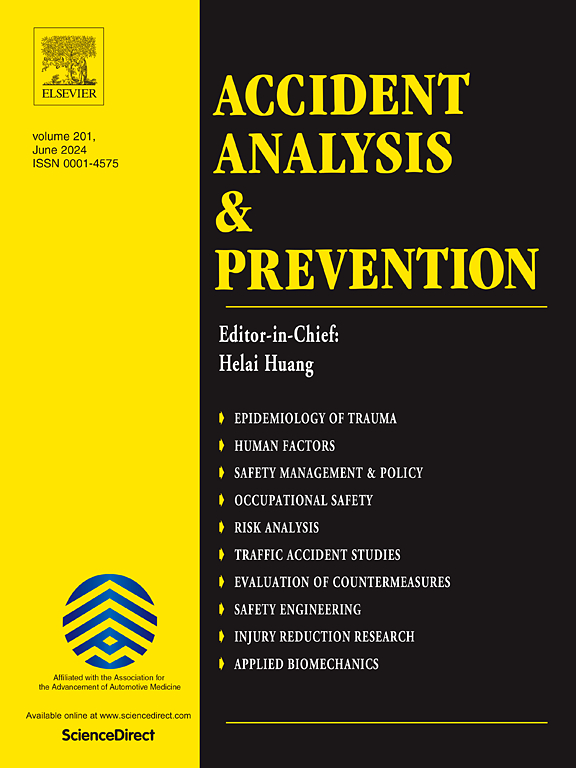A simulation study on traffic conflict risk under shockwave propagation at signalized intersections
IF 5.7
1区 工程技术
Q1 ERGONOMICS
引用次数: 0
Abstract
Traffic congestion and safety at signalized intersections are critical concerns in urban mobility management. The interaction between shockwaves caused by stop-and-go vehicles and the resultant conflict risk remains inadequately understood, necessitating detailed investigation. This study aims to explore the relationship between traffic conflict risk and shockwave propagation at signalized intersections through simulation, focusing on the dynamic conditions as vehicles queue and dissipate. The vehicle trajectory data extracted from the video captured by unmanned aerial vehicles (UAVs) is utilized in this study. The Simulation of Urban MObility (SUMO) software was selected as the simulation platform for building the simulation model. To ensure accuracy, the trajectories are refined with data smoothing and sampling, providing a reliable benchmark input for the simulation model development. Moreover, surrogate safety measures (SSMs) such as modified time to collision (MTTC) and deceleration rate to avoid a crash (DRAC), along with shockwave analysis (SA) were used to investigate the impact of driving risk when shockwave propagates in the queue. Then, the relationship between shockwaves and driving risk was explored under the calibrated model in a signalized intersection scenario. The study results show that conflicts occurred during the process of vehicles approaching until they stop and join the queue. Subsequently, the risk propagated at the tail of the growing queue. Additionally, the space–time diagram reveals that the risk propagation may be initiated before or along with the shockwave’s propagation. The findings provide insights for developing control strategies at signalized intersections through the uncovered correlation between the conflict risk and shockwave, contributing to the comprehensive understanding of traffic flow and safety at intersections.
信号交叉口冲击波传播下交通冲突风险仿真研究
信号交叉口的交通拥堵和安全是城市交通管理的关键问题。由走走停停的车辆引起的冲击波与由此产生的冲突风险之间的相互作用仍然没有得到充分的了解,需要进行详细的调查。本研究旨在通过仿真研究信号交叉口交通冲突风险与冲击波传播之间的关系,重点研究车辆排队和消散的动态条件。本研究利用了从无人机捕获的视频中提取的飞行器轨迹数据。选择城市交通仿真软件SUMO作为仿真平台,建立仿真模型。为了保证精度,对轨迹进行了数据平滑和采样,为仿真模型的开发提供了可靠的基准输入。此外,采用替代安全措施(SSMs),如修正碰撞时间(MTTC)和避免碰撞的减速率(DRAC),以及冲击波分析(SA)来研究冲击波在队列中传播时驾驶风险的影响。然后,在标定模型下,探讨了信号交叉口场景下冲击波与驾驶风险的关系。研究结果表明,冲突发生在车辆接近的过程中,直到车辆停止并加入队列。随后,风险在不断增长的队列的尾部传播。此外,时空图揭示了风险传播可能在冲击波传播之前或随着冲击波传播而开始。研究结果揭示了冲突风险与冲击波之间的相关性,为制定信号交叉口的控制策略提供了见解,有助于全面了解交叉口的交通流和安全。
本文章由计算机程序翻译,如有差异,请以英文原文为准。
求助全文
约1分钟内获得全文
求助全文
来源期刊

Accident; analysis and prevention
Multiple-
CiteScore
11.90
自引率
16.90%
发文量
264
审稿时长
48 days
期刊介绍:
Accident Analysis & Prevention provides wide coverage of the general areas relating to accidental injury and damage, including the pre-injury and immediate post-injury phases. Published papers deal with medical, legal, economic, educational, behavioral, theoretical or empirical aspects of transportation accidents, as well as with accidents at other sites. Selected topics within the scope of the Journal may include: studies of human, environmental and vehicular factors influencing the occurrence, type and severity of accidents and injury; the design, implementation and evaluation of countermeasures; biomechanics of impact and human tolerance limits to injury; modelling and statistical analysis of accident data; policy, planning and decision-making in safety.
 求助内容:
求助内容: 应助结果提醒方式:
应助结果提醒方式:


